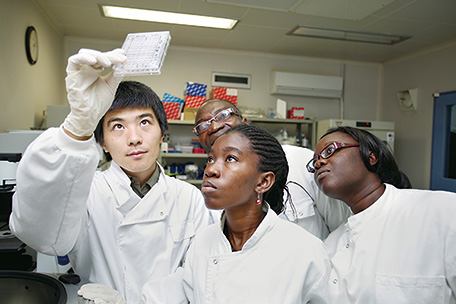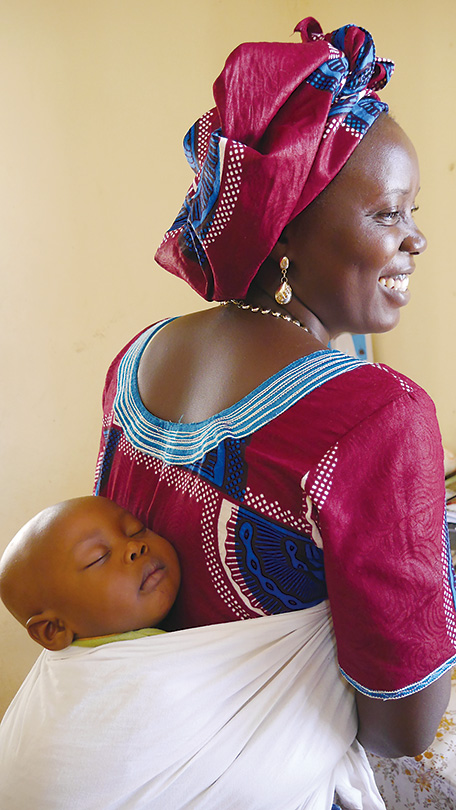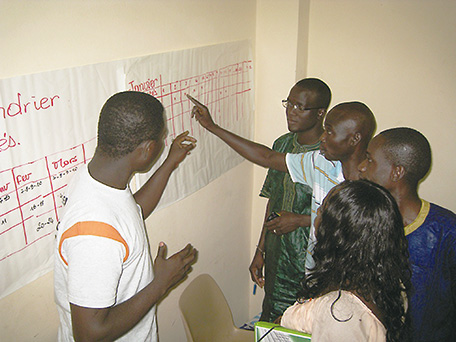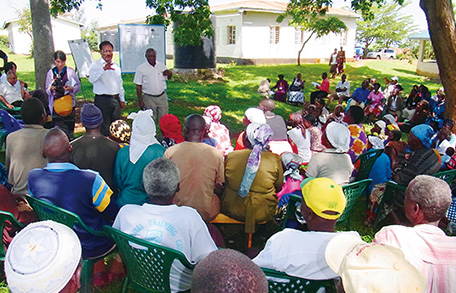(2) Health and Population
A large number of people living in developing countries do not have access to the basic health services that are usually available in developed countries. At present, the lack of an hygienic environment has led to the annual loss of 6.6 million children under the age of five due to infectious diseases, malnutrition, diarrhea, and other ailments.(Note 2) Moreover, over 280,000 pregnant women lose their lives every year without receiving emergency obstetric care by skilled birth attendants like obstetrician, gynecologist and midwives.(Note 3) Furthermore, poor countries suffer from further poverty, unemployment, famine, lack of access and quality of education, and environmental deterioration due to high rates of population growth.
To solve these problems, the international community has been working together to achieve the following health-related MDGs (MDG 4: reducing child mortality, MDG 5: improving maternal health, MDG 6: combating HIV/AIDS, malaria, and other diseases) since 2000. The target date to achieve the MDGs, the year 2015, is approaching; however, progress has been slow, especially in low-income countries, making it difficult to achieve these goals. Moreover, even in the countries in which the indicators have shown improvement, low-income families are still unable to access medical services since they cannot afford to pay the healthcare costs. Thus, disparities in health within a country have emerged as a challenge. In addition, in recent years there is a need for addressing new health issues, such as malnutrition including over-nutrition, non-communicable diseases such as diabetes and cancer, and increasing aging populations. In order to address such increasingly diversified health issues in each country and region in the world, it is important to achieve “universal health coverage (UHC)” to ensure that all people obtain the health services they need without suffering financial hardship when paying for them.
< Japan's Efforts >
| Health

The Noguchi Memorial Institute for Medical Research was built through support from Japan to commemorate the achievements of Hideyo Noguchi who conducted research on yellow fever in Ghana. In a laboratory, an expert, Mr. Makoto Uoda, repeatedly conducting experiments on extracting substances that may be useful for HIV infection from herbal plants produced in Ghana. The key to a successful experiment is a relationship of mutual trust. (Photo: Akio Iizuka / JICA)

A woman carrying her child on her back while she works in a health care center in Coyah Prefecture in Western Guinea. (Photo: Kaoru Uemura / Embassy of Japan in Guinea)
In May 2013, Japan formulated “Japan's Strategy on Global Health Diplomacy.” This strategy positions global health issues as a priority for Japan's diplomacy, and sets forth policies for the private and public sectors to work together in order to improve global health. At TICAD V in June, Prime Minister Shinzo Abe announced this strategy in the opening speech of the conference, and expressed Japan's determination to contribute to the promotion of “UHC” through which all people of the world can receive basic health care services, based on the principle that improving the health of all people is indispensable to realize human security. It was also announced that Japan will provide ¥50 billion and provide support for human resources development of 120,000 people in the field of health in the next five years.
For more than 50 years Japan has been providing a universal national health insurance system, and has become a society in which people enjoy the best health and the longest life expectancy in the world. Under this strategy, Japan will pursue such efforts as the effective implementation of bilateral assistance, strategic collaborations with global initiatives of international organizations, etc., the enhancement of domestic capabilities and the fostering of human resources.
Over the past years, Japan has attached great importance to global health, which is directly related to human security. Japan has led international discussions on health system* strengthening. At the G8 Kyushu-Okinawa Summit in 2000, infectious diseases were taken up for the first time as a major item on the agenda of the Summit. This led to the establishment of the Global Fund to Fight AIDS, Tuberculosis and Malaria (the Global Fund) in 2002.
At the July 2008 G8 Hokkaido Toyako Summit, the “Toyako Framework for Action on Global Health” was released under the agreement by the G8 nations, asserting the importance of strengthening health systems. Moreover, at the G8 Muskoka Summit (Canada) in June 2010, the Muskoka Initiative that aims to strengthen support for maternal and child health was launched, and Japan announced that it would additionally provide up to ¥50 billion, approximately $500 million, over five years from 2011.
In addition, Japan presented the “Japan's Global Health Policy 2011-2015” at the September 2010 UN Summit on the MDGs, and announced that Japan would provide $5 billion of aid (including a contribution of up to $800 million to the Global Fund), for the purpose of contributing to the achievement of the health-related MDGs over the five years beginning from 2011. The three pillars of Japan's global health policy are: (i) maternal and child health; (ii) measures against the three major infectious diseases* (HIV/AIDS, tuberculosis, and malaria); and (iii) response to public health emergencies, including polio and pandemic influenza (see page 80 for details regarding infectious diseases). Especially, in the area of maternal, newborn and child health, in which little progress has been made towards achievement of all the MDGs, Japan provides efficient assistance based on EMBRACE* in Ghana, Senegal, Bangladesh, and other countries. This approach aims to better provide comprehensive continuum of care for mothers and babies, based on the principle of ownership (independent efforts) and capacity-building of developing countries, focusing on strengthening sustainable health systems*. Moreover, Japan aims to save approximately 430,000 maternal lives and 11.3 million children's lives across partner countries in cooperation with international organizations and other development partners. In particular, for measures against HIV/AIDS, tuberculosis and malaria, Japan intends to provide effective support through complementing both financial contributions to the Global Fund and bilateral assistance, and to reduce 470,000 deaths by AIDS, 990,000 deaths by tuberculosis, and 3.3 million deaths by malaria across partner countries in cooperation with other development partners.
- *Health system
- Health system includes mechanisms for the preparation and maintenance of government systems, the improvement of healthcare facilities, the optimization of the supply of pharmaceuticals, the accurate measurement and effective utilization of healthcare information, financial administration, and the acquisition of financial resources, as well as the development and management of personnel to operate these processes and provide services.
- *The three major infectious diseases
- The three major infectious diseases refer to HIV/AIDS, tuberculosis, and malaria. Worldwide deaths from these diseases total to approximately 3.6 million. The spread of these infectious diseases significantly impacts society and the economy, and is a factor that hampers national development. Accordingly, it is a serious threat to human security, and a global issue that must be addressed by unified efforts of the international community.
- *EMBRACE (Ensure Mothers and Babies Regular Access to Care)
- EMBRACE is an assistance for strengthening the system of providing comprehensive continuum of maternal and child health care. It aims to provide continuum of care throughout the pregnancy, from pre-pregnancy (including adolescence and family planning), antenatal maternity, postnatal, newborn, to infant period, viewing these periods as a single continuum by creating linkages between family, community and primary/secondary/tertiary healthcare facilities. Specifically, such care includes checkups for pregnant women, birth assistance, immunization, improvement in nutrition, human resources development for maternal, newborn and child health, improvement of facilities with the capacity to provide emergency obstetric care, strengthening of government and medical institution systems, utilization of maternal health handbooks, and postnatal checkups.
- Note 2: Source: “The Millennium Development Goals Report 2014” (UN)
- Note 3: Source: “Trends in Maternal Mortality: 1990 to 2010” (WHO, UNICEF, UNFPA, and the World Bank)
| Senegal
Enforcement of Management of Health System in Tambacounda and Kedougou
Technical Cooperation Project (March 2011 – February 2014)

A scene from training on how to plan an annual schedule of a clinic. Nurses conducted discussions during a group work in a training for strengthening management. (Photo: JICA)
Senegal faces a serious poverty problem. The pursuit of the Millennium Development Goals (MDGs) and assistance to the poor are thus priorities for the country. In particular, Tambacounda and Kedougou, the southeast regions of Senegal which make up about one-third of the country, have high poverty rates and score poorly on major health indicators1.
The Governments of Japan and Senegal identified the Tambacounda and Kedougou regions as priority areas for Japan's development cooperation in the health sector. Since 2007, Japan has been providing support to the two regions through grant aid and the dispatch of cooperation experts, among other schemes. In addition to these activities, Japan started the “Enforcement of Management of Health System in Tambacounda and Kedougou” in 2011 to make efficient use of the limited financial and human resources available to the two regions, and thereby, to ensure the sustained improvement of their health services. Specifically, this project promotes the efficient and effective operation of medical facilities.
The project contributed to the development of the “Plan de Travail Annuel (PTA)2” of the regional health offices and health districts in the two regions, as well as of its operational guidelines (PTA Guide). In addition, relevant training programs were organized in both regions under this project. During a two-month period from August to October 2012, all management team members (81 people) from the regional health offices, regional public agencies, and 10 health districts in the two regions received training based on the PTA Guide. Other regions across the country are also beginning to utilize the PTA Guide.
Furthermore, the so-called “5S approach” (Sort, Straighten, Shine, Standardize, and Sustain) was implemented to enhance the capacity of regional health offices and health districts in the management of human resources and medical equipment. Additionally, the “Resource Management Tools Usage Guide” on human resources, drugs, and health information was compiled. This has shortened the time required by staff to access the necessary supplies, and thereby improved then operational efficiency.
The PTA Guide and the resource management training, as well as the “5S approach,” are designed to be self-sustaining. That is to say, trained staff teach new staff in place of Japanese experts. It is expected that the results of this project will be publicized inside and outside the two regions, in order to ensure that the activities continue to be implemented independently in both regions and to further scale up the activities to other regions in Senegal.
*1 Examples include the infant mortality rate, the under-five mortality rate, and the maternal mortality rate.
*2 PTA: Plan de Travail Annuel (Annual Work Plan)
| Kenya
Strengthening Management for Health in Nyanza Province
Technical Cooperation Project (July 2009 – June 2013)

A scene from a community health care meeting for the local residents. (Photo: JICA Project Team)
Kenya, located in East Africa, undertook various health initiatives with the cooperation of many development partners, and in turn, saw a steady improvement in its health indicators. However, from the mid-1990s, the HIV/AIDS epidemic and widening economic disparities, among other factors, led to the deterioration of Kenya's health indicators, including the infant mortality rate (under one year of age), the under-five mortality rate, and the maternal mortality rate. It is considered that people's lack of access to health services contributed to this outcome. The Government of Kenya took this situation seriously and decided to decentralize health administration, with the aim of improving the quality and quantity of health services. Following this, priority was given to strengthening organizational management, focusing on the capacity of health administrators in each region.
Against this backdrop, Japan implemented the technical cooperation project, “Project for Improvement of Health Services with a focus on Safe Motherhood in the Kisii and Kericho Districts,” in Kenya from 2005 to 2008. Based on the outputs and experience from this project, from 2009 to 2013, Japan implemented the technical cooperation project, “Strengthening Management for Health in Nyanza Province,” where there was an especially poor showing on critical health indicators among the regions in West Kenya.
This project dispatched five long-term experts and one short-term expert to Nyanza Province in order to strengthen the capacity of its health administrators. In addition, a consortium was established with universities and research institutions in Kenya. For the establishment and implementation of health system management training, the consortium developed management training methods and teaching materials, as well as management tools such as management handbooks. Furthermore, to improve health services, the project helped Kenya create health promotion handbooks, provided support for health promotion activities in the pilot districts (where training was conducted on a trial basis), and implemented training for community health workers. For example, the project conducted a public awareness-raising campaign that encouraged children to wear footwear to prevent infection from sand fleas which parasitize the soles of the feet. Japan's assistance for both health service providers and beneficiaries has helped significantly improve the basic health service provision coverage rate1, which recorded an average increase of 28% in the whole Nyanza Province (51% in Siaya District and 58% in Kisumu West District, selected districts in the province).
*1 The percentage of people with direct access to basic health services (the percentage with access to services such as prenatal check-up, facility childbirth, measles vaccination, and family planning).
